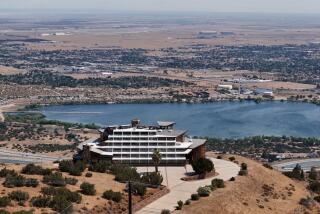The Home Front Lines
- Share via
Lynne Plambeck thinks of bulldozers whenever she hears Lennar Corp.’s name.
Two years ago, when the home builder was developing Stevenson Ranch just west of Santa Clarita, it planned to chop down 36 century-old oak trees. Plambeck, president of the Santa Clarita Organization for Planning and the Environment, or SCOPE, sought a temporary restraining order to save the oaks.
Lennar moved faster. As Plambeck and her lawyers waited for a judge to convene a hearing in the case, she recalled, bulldozers finished knocking down 27 of the trees to clear a path for a road, saving nine to replant elsewhere on the ranch.
“Our hearts just sank,” Plambeck said. “We walked out of court so shocked that they would do that.”
The bulldozing wasn’t illegal, because a restraining order hadn’t been issued. But according to Plambeck, what Lannar did was unprincipled, and not surprising for the Miami-based home builder.
Now that Lennar has agreed to buy the company that is developing the controversial Newhall Ranch project, Plambeck warns that the whole state “is in for more trouble.”
Lennar officials said they couldn’t comment on the Stevenson Ranch oak-tree controversy because of continuing litigation; SCOPE has challenged in court an environmental report from Lennar on one phase of the project.
But Jon Jaffe, a vice president in Lennar’s Mission Viejo office, said the criticism from Plambeck -- and from environmentalists and growth opponents who regarded Lennar as an insensitive outsider -- was off the mark.
“We pride ourselves on quality, and sensitivity and being part of the communities we serve,” Jaffe said. “We have a job to do, yes, but are not this huge, nameless firm that cares less about an area because we’re not headquartered there. We have a vested interest in doing things right.”
In less than a decade, Lennar has gobbled up a dozen smaller companies, including two of Southern California’s largest builders, to overtake Los Angeles-based KB Home as the state’s biggest home builder. If it acquires Valencia-based Newhall Land & Farming Co., Lennar will gain control of Newhall Ranch, a prime plot of 47,000 acres in land-constrained California.
Lennar and its partner, LNR Property Corp. of Miami, agreed this week to pay $990 million for 120-year-old Newhall. The 12,000-acre Newhall Ranch development, the largest single housing development approved by Los Angeles County, has been targeted by environmental groups as an example of unbridled growth in the northwest corner of the county.
Lennar is well-regarded by customers; the company ranked No. 5 and well above the average in J.D. Power & Associates’ customer satisfaction survey of Southern California home builders last year.
And Wall Street is enamored of the company.
With a serious appetite for growth, timely acquisitions and a quirky corporate culture, Lennar has managed to sprout into the nation’s third-largest home builder and, by its own account, the most profitable.
Last year Lennar raked in revenue of more than $7 billion and earnings of $545 million.
“They’ve just had this uncanny knack for sniffing out deals,” said Jeff Meyers of Meyers Group, a real estate industry research firm in Costa Mesa. “They’re a super hard-charged company and their timing is usually pretty impeccable.”
Investors liked the Newhall deal too; Lennar stock rose $2.04 to $68.50 a share on Tuesday and Newhall’s jumped $5.43 to $38.83. On Wednesday, Lennar fell 42 cents to $68.08 a share and Newhall lost 3 cents to $38.80 a share.Founded in 1954 by Leonard Miller and Arthur Rosen, Lennar entered the California market in 1996, just as the state was emerging from its long housing slump.
Since then it has purchased at least a dozen smaller home builders throughout the state, most notably Pacific Greystone in Los Angeles, Century Pacific in Riverside and ColRich Communities in San Diego.
Lennar builds single-family and multifamily homes nationwide under the Lennar name and others, including U.S. Home and Greystone Homes in California.
About 5,500 of the 27,000 homes Lennar built last year were in California, accounting for about a fourth of its total revenue. That’s proof, Lennar officials say, that they have roots in the Golden State.
“With that kind of a presence, I don’t think we qualify as an outsider,” said Jeff Roos, regional homebuilding president of Lennar in Southern California. “We may not have a long history here, but we’re very much a part of California.”
That history includes skirmishes over projects like North Natomas in Sacramento, where Lennar successfully sued the city for holding up development until environmental issues were resolved.
“They basically went after us,” said Sally Weaver, a resident who opposed parts of the North Natomas development. “We had the city trying to do the right thing, and [Lennar] beat them down. They won.”
Lennar doesn’t always win. In Tarpon Springs, Fla., the developer scrapped plans to build a cluster of upscale townhomes after it ran into opposition from neighbors. It is known for good deeds, as well: After Hurricane Andrew hit south Florida, Lennar responded to lawsuits from homeowners who blamed it for shoddy construction by setting up programs to help residents clean and rebuild. In the end, state investigators blamed lax building codes, not the builder.
Lennar’s push through California began in earnest when Leonard Miller’s son, Stuart Miller, took over as president and CEO in 1997. The younger Miller brought a new management style to the company, drawing Dr. Seuss stories to motivate a staff of about 8,000 employees in 16 states.
Besides following his father’s business lead in cutting corporate debt and overhead so he could buy land for less during the rough times, Miller introduced a culture to Lennar that included weekly bag lunches, “feel good” meetings and a penchant for a poem called “Scratchings From the Little Red Hen,” which he made everyone memorize and still uses as an example of good problem solving.
Miller maintained much of his father’s business sense. He diversified by moving into new markets, spending nearly $2 billion on land a year and choosing developments from infill work on projects in downtown San Francisco to master-planned communities in Orange and Los Angeles counties.
Lennar has what Jaffe calls a “well-balanced yet diverse product supply” that means the company doesn’t have to be too reliant on any one state.
“We’re moving on all fronts,” Jaffe said. “Some would say we’re aggressive, but I wouldn’t call it that. I’d call it being opportunistic.”
That strategy, along with low interest rates, rising home prices and strong sales, has allowed Lennar to remain profitable in a slow economy.
And when other builders advertise customized floor plan options and other designer amenities, Lennar has gone against the idea and offers fewer choices, which increase efficiency and lowers costs.
The company “has exhibited excellent execution across diverse regions and product segments,” said Margaret Whelan, an analyst with UBS Research in New York. “It’s our favorite large-cap home builder.”
More to Read
Inside the business of entertainment
The Wide Shot brings you news, analysis and insights on everything from streaming wars to production — and what it all means for the future.
You may occasionally receive promotional content from the Los Angeles Times.










